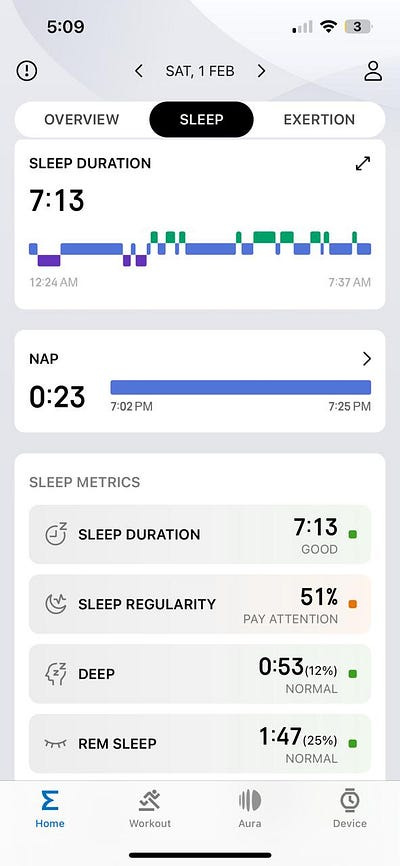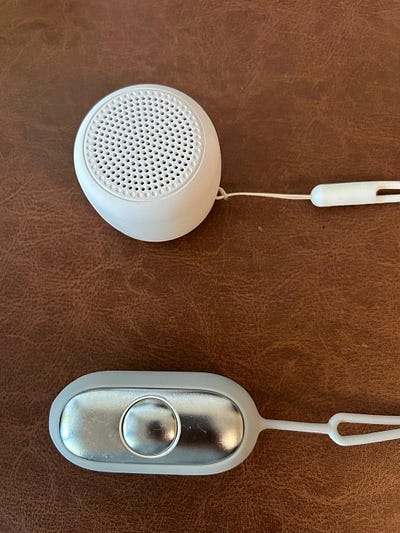Can Technology ‘actually’ help us sleep better? 😴
After our visit to the human sleep laboratory at NIMHANS, Deepali and I were excited to improve our sleep with everything we had learned…
After our visit to the human sleep laboratory at NIMHANS, Deepali and I were excited to improve our sleep with everything we had learned. We started by enhancing our sleep hygiene, ensuring we went to bed consistently at 11 PM and woke up at 7 AM. Additionally, we made sure to have dinner by 7:30 PM and avoided screen time after 8 PM. While these measures helped us wake up feeling refreshed each morning, our curiosity pushed us to explore ways to measure and optimize our sleep.
As a starting point, we began tracking our sleep every night using our Amazfit watch, which was usually lying around discharged before this. While it was fun to see our sleep time, wake-up time, deep sleep duration, and sleep stages, we weren’t sure what to do with the data. Aside from calling each other out for not going to bed by 11 PM or sympathising when one of us didn’t get enough deep or REM sleep, we didn’t know how to actually improve the quality of our sleep further.
In our pursuit of finding a reasonable answer, we tried various solutions and products we found on the internet. We realized that we were only tracking our sleep on nights when we felt good before going to bed. However, on nights when we struggled to sleep due to illness or overthinking, the first thing we did was remove our watch and place it on the side table, as we weren’t used to sleeping with a watch on our wrists. It felt more like a hindrance than a help on the days we needed it most! We also tried an under-the-mattress sleep tracker similar to Withings, only to notice a very similar pattern. Maybe it was the sleep performance anxiety of knowing we were going to get bad data on nights we already felt bad? We’re not sure. 🤔

Objective vs. Subjective Sleep Tracking
While the smartwatch provided us with some objective data, we also wanted to track subjective factors from the evening before sleep — such as caffeine intake, chamomile tea consumption, any medications taken, and, most importantly, whether we had traveled during the day. To do this, we bought a sleep journal, which we diligently filled in on good days but found ourselves avoiding on bad days. Maybe sleep tracking could only be maintained consistently if we saw some improvements on a regular basis. With this in mind, we decided to explore other solutions that claimed to enhance sleep.
Trying Out White Noise and Micro-Current Stimulation
White Noise — We realized that white and pink noise have helped many people fall asleep faster and experience fewer awakenings due to fewer disturbances during the night. Excited by this, we got a device specifically for white noise, only to find it irritating — probably because we weren’t used to it. Later, I learned from my friends that it works well for some people, especially babies, as they are familiar with similar sounds from the womb.
Micro-current Simulation — Some devices claim to use microcurrent stimulation to influence the central nervous system, potentially promoting the production of melatonin and endorphins, which are involved in sleep regulation and mood enhancement. These devices may aim to modulate brain activity, including strengthening delta waves, which are associated with deep sleep. While some studies suggest that electrical stimulation can impact brainwave activity and sleep quality, the exact mechanisms and effectiveness of microcurrent devices for improving sleep are still being researched and are not fully established. Personally, when we used this device, the microcurrent pulses had the opposite effect, awakening us when we were dozing off to sleep! 🤨
Learning from Others’ Sleep Journeys
We also decided to explore the experiences of our friends, as well as others on LinkedIn and Reddit, who may have tried devices or solutions to optimize sleep. We spoke to around 50 people about their sleep journeys, trying to understand what had helped them — or not helped them — improve their sleep. We found a few common patterns!
60% of the people who recovered from a phase of insomnia did so primarily by making changes and strictly adhering to sleep hygiene practices. Specifically, they went to sleep regularly at a fixed time, avoided meals at least 3 hours before bedtime, avoided screen time at least 1–2 hours before going to bed, and maintained a cool bedroom environment. That’s it! Each of them had read the book Why We Sleep by Matthew Walker.
25% of the people who were experiencing sleep issues mentioned that meditation, particularly breathing exercises just before bedtime, helped them sleep better when overthinking was the cause of insomnia. This was mainly during times of stress, including experiences like becoming new parents, job loss, or illness in the family. Personally, I also found that meditation helped me calm my mind, making it easier to fall asleep.
While supplements such as melatonin, ashwagandha, and magnesium helped some of them, only 5% had tried taking supplements for sleep. Additionally, visiting a general practitioner for sleep issues did not lead to any significant outcomes.
None of them knew exactly what to do with the sleep stage data from their Apple Watch, Whoop, or Ultrahuman Ring. 🤨
Final Thoughts
It’s interesting that sleep hygiene and breathing exercises proved to be the most effective ways to enhance sleep quality. Currently, most sleep technologies are focused solely on capturing sleep data. I’m eager to see how technology can make it easier to incorporate these habits into everyday life. If you are working in this space, I would love to brainstorm.



